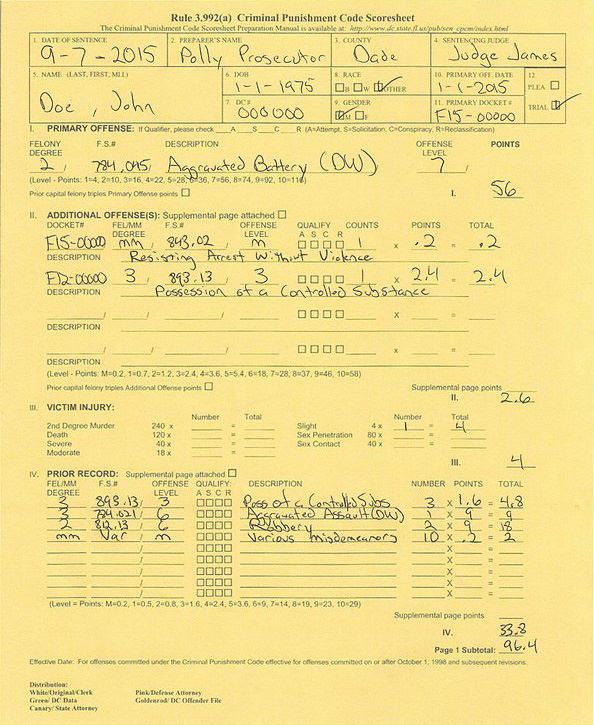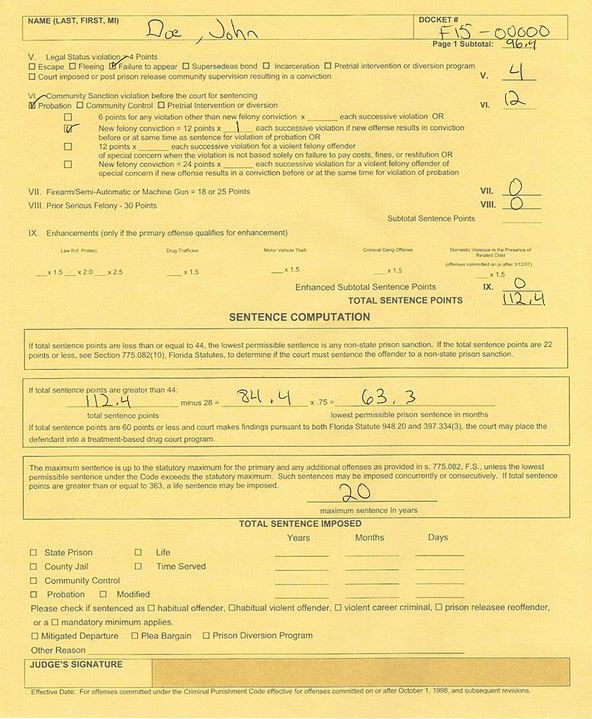Did the prosecutor in your case just tell the judge that you “score out” to prison time? Are you wondering how they got to that number? Prosecutors use “criminal punishment scoresheets” to calculate the number of months of prison time. They add the points from your primary offense level, additional offense levels, victim injuries, prior record, legal status violations, community sanction violations, and other enhancements, and you get your “total sentence points”.
Then, they simply take your total sentence points, subtract 28 points, and multiply by .75. This is the number that you “score out” to or the bottom of your guideline range. This number is important because this is the lowest amount of prison time that the judge can sentence you to unless the state agrees to a lower sentence or you qualify for a legal departure from the sentencing guidelines.
Confused yet? You should be. There is a reason criminal defense attorneys spend years in law school and in practice before they even touch one of these scoresheets. They are very complex and very important. Just one mistake on your scoresheet could make the difference between you going to prison or getting probation. You should hire an experienced criminal attorney to review your scoresheet to ensure your guidelines score is correctly calculated.
While you might not understand some of the legal aspects of correctly calculating your sentencing guidelines score, there are still some things that you can do. Prosecutors have hundreds of cases. Sometimes they make mistakes. Here are some helpful tips that will ensure that you don’t get more time than you deserve.
1. Review Your Background Information
Make sure the Defendant on the case is you!
2. Review Your Current Charges
Make sure the charges under “Primary Offense” and “Additional Offenses” accurately reflect your charges.
3. Review Your Prior Record
Make sure the charges under “Prior Record” accurately reflect your past criminal history. Sometimes prosecutors do not have accurate criminal histories that reflect that prior charges have been dismissed or pled to lesser included offenses. This is more likely if you have prior arrests or charges in a different county or state.
4. Review The Prosecutor’s Math
Finally, make sure the prosecutor’s math is correct. A simple mathematical error that you learned in 3rd grade could cost you years of your life. Simply add the points on each page to calculate your “total sentence points”. Subtract 28 points from that total and then multiply by .75. This is the number that you “score out” to or the bottom of your guideline range. Here is an example below:
Suppose John Doe is on probation for Possession of Cocaine. He gets in an argument with his girlfriend and lunges at her with a knife causing a small cut on her left arm. A neighbor call police and they arrive very quickly. Mr. Doe runs out the back door and jumps a fence. He is apprehended by police a short distance from his home. After bonding out of jail, he fails to appear at his arraignment because he is scared. He is arrested on a warrant a few months later and held in custody until his trial. At trial he is found guilty of Aggravated Battery with a Deadly Weapon and Resisting Arrest Without Violence. He is also found in violation of his probation for Possession of Cocaine. Mr. Doe has three prior convictions for Possession of Cocaine, two prior convictions for Robbery, one prior conviction for Aggravated Assault, and ten prior misdemeanor convictions for various crimes. Under the following fact scenario, this is what Mr. Doe’s scoresheet would look like:

Mr. Doe would receive 96.4 points for his “Primary Offense”, “Additional Offenses”, “Victim Injury Points”, and his “Prior Record”.

Mr. Doe would receive 4 points for failing to appear to arraignment and an additional 12 points for the probation violation bringing his total sentence points to 112.4. After subtracting 28 points from the total sentence points and multiplying by .75, Mr. Doe scores out to 63.3 months florida state prison at the bottom of the guidelines.
He faces a maximum sentence of 20 after combining the maximum sentence for Aggravated Battery with a Deadly Weapon (15 years) with the maximum sentence for a violation of probation for Possession of Cocaine (5 years). Therefore, unless there is a legal reason to depart from the sentencing guidelines, the Judge would be required to sentence Mr. Doe to somewhere between 63.3 months to 20 years in prison.
Disclaimer:
Please note that by reading this blog you are not entering into an attorney-client relationship with Hubbs Law, P.A. This blog only provides general legal information. Every case is unique and you should request a consultation to ensure that you are getting the correct legal advice for your specific case.

